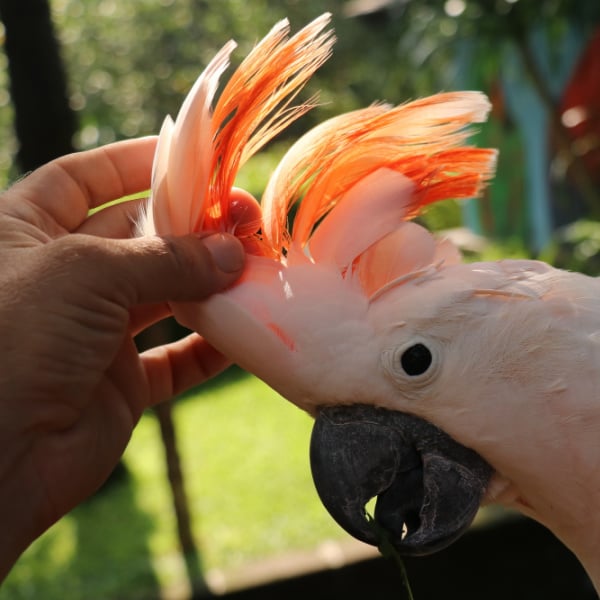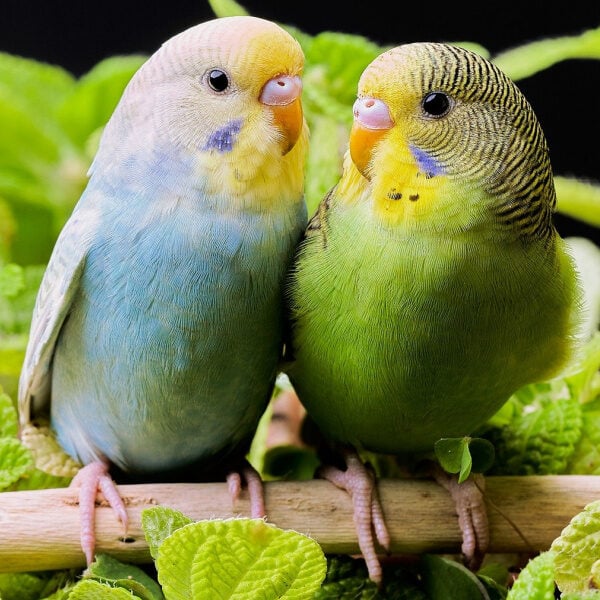Last Updated on by Mitch Rezman
There is no one single answer to that question.
Your biggest friend is patience.
How patient?
In October of 2018, I drove 800 miles to rescue an African ringneck.
Almost 4 years later he will still severely bite any approaching human given the opportunity in a flash.
Our best guess is that he was 15-16 when we got him so to say he was set in his ways is an understatement. We also feel he was mishandled by a caregiver while his owner suffered from a long hospital stay.
We are fortunate enough to be able to handle Keto with a particular yellow ball and bell toy that he came with and dearly loves.
That one toy is the difference between us possibly rehoming him and our being able to care for him daily.
He’s the sweetest bird with a great vocabulary and loves to talk, especially when he has an audience of new-found friends.
But get within the reach of that beak, in a flash, blood will be oozing from your skin.
I accept the fact that having a bird means you will get bitten now and then but I do everything I can to simply avoid the bite.
I see way too many images on social media of people holding up their scarred and swollen hands probably saying “ This is what I endure having a parrot.” “sigh”.
Over the years we’ve learned what he considers to be high-value treats.
It used to be peanuts in the shell which took a lot of time to extract and he would always waste the second peanut.
Now he has thoroughly warmed up to fat sunflower seeds in the shell.
I can already see some of you fidgeting in the back row with your hands up to tell me about how bad sunflower seeds are for parrots.
That thought obscures a lot of pet bird keepers. I’m thinking about using sunflower seeds as a high-value treat.
For the first time in three and a half years, I am now able to walk up to Keto and hand him a sunflower seed in the shell without his ripping flesh and my losing blood.
Should We Anesthetize Birds for Exams and Blunt Their Beaks?
Chili, our rescued quaker will trust and fly to anyone, whether they like it or not.
Barney, our rescued cockatiel, after 2 years with us will still upon being approached, fly off to sit atop the drapes and then bolt across the length of the house only to repeat this over and over until he gets weary. Or we do.
I feel as though he likes getting the attention because he eventually hops onto my arm and then crawls up to my shoulder awaiting transport to his next destination of my choosing. But it also may be exhaustion.
How does this information help you?
By illustrating different scenarios.
Each and every bird has a history even newborns.
How can that be?
100 million years of evolutionary expectations are embedded in every bird hatched today.
Once they are brought up by parents and then fledged, they instinctively know how to:
- Forage for and find food.
- Interact with a potential mate.
- Instinctively fly away from a predator.
None of those are learned responses.
I talk a lot about how we view birds and most pets from an anthropomorphic viewpoint which is where we usually get off on the wrong zygodactyl foot.
Your birds cannot meet your expectations until they understand your expectations.
If you want your bird to step up, your bird wants to know why he or she should step up.
If after stepping up, they receive a high-value tree like an unshelled sunflower seed the bird will more easily rationalize the action.
And so it goes. Maybe it is bribery. Whatever works.
Knowing the history of a bird is very important.
If a bird spent 6 years incarcerated in a rescue in a small cage 23 hours a day, you’ll not be doing it any favors by providing total freedom.
It felt secure within its cage and the bird may need time to adjust to being outside of the cage.
Some rescue birds come from feather flocks in end up being the sole center of attention pet.
That bird could be looking for something or someone to bond with if they had such a relationship prior.
If your bird is exhibiting aggressive behavior when you put your hand in the cage, don’t put your hands in the cage.
All of our cages have a (grooming) perch mounted on the inside of the cage door.
This is so the bird can be on the perch inside, then once the door is opened, they are now outside of the cage which makes for an easy pick up by you without attitude.
The bonus of it being a grooming perch is they are filing their nails while waiting for you to open the door.
Parrots are prey animals – except for Quakers that live in the hollows of trees and under rocks not in the open like many songbirds.
A birdcage interior is sacred to the bird and sticking your hand in there is invading sacred land so stop it!
Your starting point for developing trust with birds should be clicker training (see video above).
A few minutes a day, the time it takes you to brush your teeth can be a game-changer in the relationship between you and your bird.
Written by Mitch Rezman
Approved by Catherine Tobsing
Author Profile
Latest entries
 The Traveling BirdJune 26, 2025Can You Name 5 Parrot Species That Are Living Wild in the USA?
The Traveling BirdJune 26, 2025Can You Name 5 Parrot Species That Are Living Wild in the USA? Bird BehaviorJune 26, 2025How is it Parrots Are Problem Solvers Social Animals and Even Use Tools?
Bird BehaviorJune 26, 2025How is it Parrots Are Problem Solvers Social Animals and Even Use Tools? Bird & Parrot AnatomyJune 25, 2025How a Tiny Chemical Modification Makes Parrots Nature’s Living Paintings
Bird & Parrot AnatomyJune 25, 2025How a Tiny Chemical Modification Makes Parrots Nature’s Living Paintings PigeonsJune 20, 2025How Do Parrots Thrive in Cities Outside Their Native Habitats?
PigeonsJune 20, 2025How Do Parrots Thrive in Cities Outside Their Native Habitats?




